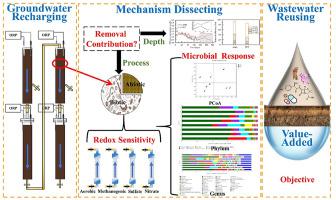Chemosphere ( IF 8.8 ) Pub Date : 2021-06-04 , DOI: 10.1016/j.chemosphere.2021.131011 Kena Qin 1 , Qingliang Zhao 1 , Hang Yu 1 , JianJu Li 1 , Junqiu Jiang 1 , Kun Wang 1 , Liangliang Wei 1

|
The abundant existence of antibiotics within the effluent of wastewater treatment plant seriously threatened their safety recharging. To investigate the fate and biodegradation of those toxic antibiotics within the soil aquifer system, typical antibiotics of amoxicillin (AMX) and tetracycline (TC) were selected and their removal mechanisms were investigated. Experimental results revealed that totally 93.4% and 87.2% of the AMX and TC recharged (10 μg/L) were, respectively, removed within 1 m depth column operation. Specifically, the aerobic biodegradation, abiotic processes and anoxic/anaerobic microorganism contributed as higher as 37.5%, 33.7% and 28.8% of the AMX reduction, via the controlling tests of NaN3 inhibition and soil sterilisations. By contrast, the percentage contribution of the TC was aerobic (54.3%) ˃abiotic processes (32.7%) ˃anoxic/anaerobic (13.0%), a higher aerobic degradation whereas weaker anoxic/anaerobic microorganism. Column systems (CSs) were constructed to study the effect of redox conditions (methanogenic, sulfate-reducing, nitrate-reducing, aerobic) on antibiotics degradation, and microbial community results revealed that Verrucomicrobia, Actinobacteria, Deinococcus—Thermus and Armatimonadetes contributed to the aerobic biodegradation of TC. For comparison, AMX could be efficiently degraded under nitrate reduction (19.95%) > sulfate reduction (16.64%) > methanogenic (9.53%), and Actinobacteria, Bacteroidetes and Verrucomicrobia were the dominant bacteria for AMX degradation. This study provided optimal directions for antibiotics removal within the groundwater recharging systems and is conducive to obtain highly value-added reclaimed water.
中文翻译:

地下水回灌再利用过程中阿莫西林和四环素的去除趋势:氧化还原敏感性和微生物群落响应
污水处理厂出水中大量存在抗生素,严重威胁其安全回灌。为了研究土壤含水层系统中这些有毒抗生素的归宿和生物降解,选择了典型的阿莫西林 (AMX) 和四环素 (TC) 抗生素,并研究了它们的去除机制。实验结果表明,在 1 m 深度的柱操作内,分别去除了 93.4% 和 87.2% 的 AMX 和 TC 再充填(10 μg/L)。具体而言,通过 NaN 3的控制测试,好氧生物降解、非生物过程和缺氧/厌氧微生物对 AMX 还原的贡献高达 37.5%、33.7% 和 28.8%抑制和土壤消毒。相比之下,TC 的百分比贡献是好氧 (54.3%) ˃ 非生物过程 (32.7%) ˃ 缺氧/厌氧 (13.0%),有氧降解较高,而缺氧/厌氧微生物较弱。构建柱系统 (CSs) 以研究氧化还原条件(产甲烷、硫酸盐还原、硝酸盐还原、有氧)对抗生素降解的影响,微生物群落结果显示,疣微菌、放线菌、奇异球菌 - 栖热菌和 Armatimonadetes 有助于有氧TC 的生物降解。相比之下,AMX可以在硝酸盐还原(19.95%)>硫酸盐还原(16.64%)>产甲烷(9.53%)下有效降解,放线菌、拟杆菌和疣微菌是AMX降解的主要细菌。


























 京公网安备 11010802027423号
京公网安备 11010802027423号